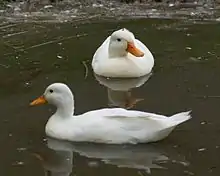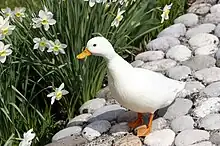 | |
| Conservation status | |
|---|---|
| Distribution |
|
| Use | |
| Traits | |
| Colour | about twenty recognised colours[4][5] |
| Classification | |
| APA | [6]: 18 |
| EE | no[7] |
| PCGB | [8] |
| |

The Call is a historic breed of small domestic duck.[9][10][11] It is believed to have originated in the Netherlands, where the earliest descriptions and depictions of it date from the seventeenth century. It is similar in appearance to some other breeds of duck, but is much smaller, with a round head and very short bill. Ducks, but not drakes, are very loquacious and noisy, with a piercing high-pitched call which can be heard from far away.[12]: 88 [13]
The Call was in the past used as a decoy duck, to attract wild duck into traps.

History
The first recorded mentions of the breed are from the Netherlands where it was used as a decoy and known as a coy or decoy duck. The high-pitched distinctive call was used to lure other ducks into funnel traps. Later, hunters would tether call ducks to draw other species within range. It is believed to have originally come from the Far East, although no records of its introduction to the Netherlands exist. Other bantam breeds are known to have been imported to the Netherlands in the 17th century and Van Gink, writing in The Feathered World in 1932, supposes "There is a possibility that importations were made by Dutch captains from Japan ... especially as the Call Duck's type is very different from the ordinary European type of duck to sport from it, and since they breed so true they must be a very old-established breed."
It was introduced to the British Isles by the 1850s.[14][15] By 1865, it was one of the first six waterfowl breeds to be standardized there, but by the middle of the 20th century they were rare. Determined efforts by a few breeders re-popularized the breed and today they are common. They are popular exhibition birds and win more duck championships in shows in North America than any other breed. Call duck themed cafés, where the ducks are petted by customers, have been opened in various cities of China.[16]
Australian call duck
Though in many ways similar, the Australian Poultry Standard Committee considers the call ducks present in Australia a separate breed to the call duck of the rest of the world, citing evidence of its independent development in South Australia as a mutation in domestic mallard flocks belonging to Hamish Russel.[17] The committee therefore put into motion a renaming of the breed for the 2nd edition, 2011, of their standard. The Australian Poultry Standards states in its introduction of the Australian call that the breed is noticeably larger and has a different colour range to North American calls.[18]
Characteristics
It is a small duck, weighing approximately 800 g; drakes may weigh up to 100 g more, and ducks up to 100 g less.[4]
In the Netherlands about twenty colours are recognised;[4] about the same number are recognised by the British Waterfowl Association and the Poultry Club of Great Britain in the United Kingdom.[5][19]: 410 In the United States the grey and white varieties were included in the first Standard of Perfection of the American Poultry Association in 1874; six other colours were added between 1977 and 2007.[6]
References
- ↑ Barbara Rischkowsky, Dafydd Pilling (editors) (2007). List of breeds documented in the Global Databank for Animal Genetic Resources, annex to The State of the World's Animal Genetic Resources for Food and Agriculture. Rome: Commission on Genetic Resources for Food and Agriculture, Food and Agriculture Organization of the United Nations. ISBN 9789251057629. Archived 23 June 2020.
- 1 2 Transboundary breed: Call. Domestic Animal Diversity Information System of the Food and Agriculture Organization of the United Nations. Accessed August 2022.
- ↑ Hollandse Kwaker (in Dutch). Wageningen: Stichting Zeldzame Huisdierrassen. Archived 20 August 2017.
- 1 2 3 Jan van Pieterson (August 2012). De Kwaker (in Dutch). European Poultry Society. Archived 25 May 2016.
- 1 2 Bantam ducks. British Waterfowl Association. Accessed August 2022.
- 1 2 APA Recognized Breeds and Varieties: As of January 1, 2012. American Poultry Association. Archived 4 November 2017.
- ↑ Liste des races et variétés homologuée dans les pays EE (28.04.2013). Entente Européenne d’Aviculture et de Cuniculture. Archived 16 June 2013.
- ↑ Ducks. Poultry Club of Great Britain. Archived 9 November 2018.
- ↑ Dave Holderread (2001). Storey's Guide to Raising Ducks. North Adams, Massachusetts: Storey Publishing. ISBN 158017258X.
- ↑ Chris Ashton, Mike Ashton (2001). The Domestic Duck. Ramsbury, Marlborough: The Crowood Press. ISBN 9781847979704.
- ↑ Victoria Roberts (2008). British Poultry Standards: complete specifications and judging points of all standardized breeds and varieties of poultry as compiled by the specialist breed clubs and recognised by the Poultry Club of Great Britain, sixth edition. Oxford: Blackwell. ISBN 9781405156424.
- ↑ Chris Ashton, Mike Ashton (2009). Keeping Ducks and Geese. Cincinnati, Ohio: David & Charles. ISBN 9780715331576.
- ↑ Dave Holderread (2011). Storey's Guide to Raising Ducks, second edition. North Adams, Massachusetts: Storey Publishing. ISBN 9781603427456.
- ↑ "Irish Breeders of Call Ducks. Browse our list of breeders who raise and sell Call Ducks". Irishfowl.com. Retrieved 29 April 2013.
- ↑ Ornamental, aquatic, and domestic fowl, and game birds: their importation, breeding, rearing, and general management by Nolan, James Joseph.
- ↑ "Cat cafes are so last decade. This coffee shop in China has quacked the code on what people want to pet when they order their latte". South China Morning Post. Agence France-Presse. Retrieved 24 August 2020.
- ↑ Russell, Hamish (June–July 2010). "The Australian Call Duck". Australasian Poultry. 21 (2): 22–23.
- ↑ Australian Poultry Standards (2nd ed.). Victorian Poultry Fanciers Association (trading as Poultry Stud Breeders and Exhibitors Victoria). 2011. pp. 236–243. ISBN 978-1-921488-23-8.
- ↑ J. Ian H. Allonby, Philippe B. Wilson (editors) (2018). British Poultry Standards: complete specifications and judging points of all standardized breeds and varieties of poultry as compiled by the specialist breed clubs and recognised by the Poultry Club of Great Britain, seventh edition. Chichester; Hoboken, New Jersey: Wiley Blackwell. ISBN 9781119509141.